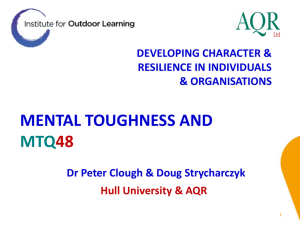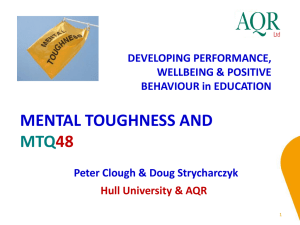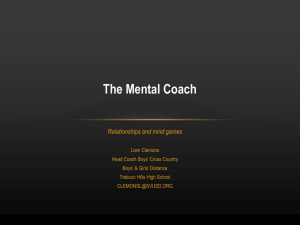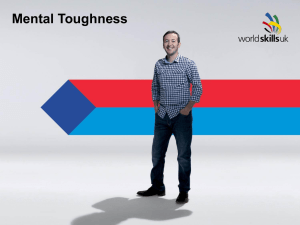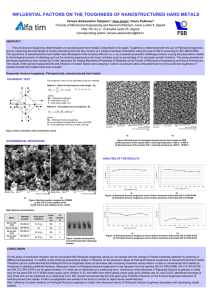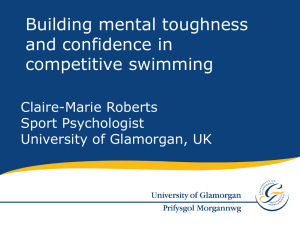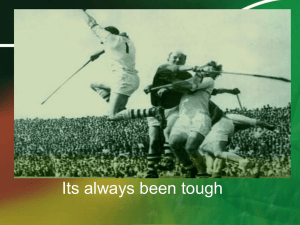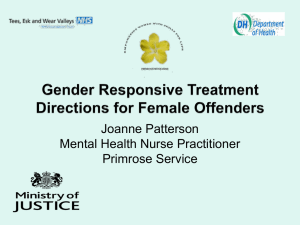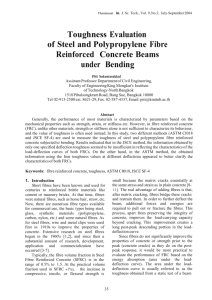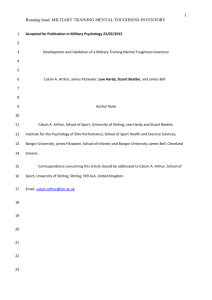Mental Toughness and its central role
advertisement
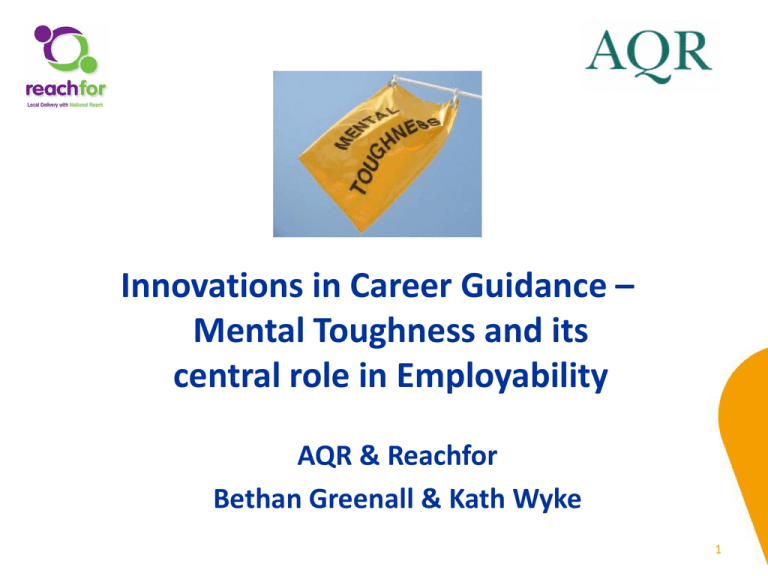
Innovations in Career Guidance – Mental Toughness and its central role in Employability AQR & Reachfor Bethan Greenall & Kath Wyke 1 What is MENTAL TOUGHNESS? “A personality trait which determines in large part how people deal with challenge, stressors and pressure .... irrespective of prevailing circumstances” It’s universal – it’s important for everything we do. Employability is about… Abilities – how you carry out certain types of mental activities Interests and motivations – what really interests you? Personality – how you react to people, situations and environments Personal Work Characteristics – characteristics displayed in work e.g. others may see you as risk-taking, optimistic in outlook, careful, cautious etc. Knowledge – information acquired through education and experience Skills – something specific you can do to a certain standard Work Environment – where and how you work 3 Why is mental toughness important? Performance – explains up to 25% of the variation in attainment Behaviour – more engaged, more positive, more “can do” Wellbeing – more contentment, better stress management , less bullying Attainment - Transition – Aspirations - Retention – Employability - Social Mobility – Career Guidance Is it important? Yes! Pulls together notions which are important and are current but are nearly all poorly defined and poorly evidenced. Character Resilience Grit Curiosity Tenacity Temperament Attitude Mental Toughness is well evidenced and solid. It embraces all of the above. APPG on Social Mobility 2013 National Career Council 1st Report – July 2013 Cabinet Office 2013 Performance Perform better in targeted settings – MBO, exams and tests Produce better reports, coursework Achieve more – cover more subjects/things Work harder Competitive Studies show that up to 25% of the variation in an individuals performance on tests can be explained by their mental toughness Behaviour More positive – “can do” More likely to respond positively to change More likely to engage – will volunteer for activities More likely to accept responsibility Better disciplined - attendance Wellbeing Deal better with stress and pressure Sleep better! Less likely to develop mental health issues Can relax even after the most challenging time Report much less bullying behaviour Less likely to consciously adopt bullying behaviour Employability (and aspirations) More ambitious Set higher standards More confident Adopt a competitive approach More likely to get a job 2011 employability study showed that more mentally tough graduates found work: More quickly Related to what they wanted to do And performed better in the role Transition Deal better with New settings - schools/jobs/employers New programmes & courses New managers/tutors/colleagues, etc. New experiences and opportunities Change programmes, takeovers and mergers Completion on Time and on Target More stick-ability – will complete programmes Better at project management Take setbacks and change in their stride Will respond to failure by saying “I can do better ….” The Four C’s Mental Toughness has 4 components: Challenge Control Commitment Confidence Which combine to provide an overall measure of Mental Toughness Think of these as aspects of mindset. Commitment “stick-ability”. Describes to what extent you will “make promises” and the extent to which you will keep those promises. Those promises can be made to others or to themselves. When asked to do something to a target by a certain time & date do you instinctively think: I’ll go for that and I’ll do what it takes or I’ll never manage that – I’ll look stupid when I fail. Control “Can do”. Describes to what extent you believe you shape what happen to you and manage your emotions when doing it. There are two components : Life-Control Emotional Control When asked to do something , is your default response: I can do it …. without needing to check if it is possible I’ll stay in control of my emotions Challenge “drive”. Describes to what extent you challenges, change, adversity & variety as opportunities or as threats. When asked to do something significant or challenging is your immediate response to say: That’s great – I look forward to whatever emerges or Oh no! I like things the way they are – I'm frightened by what might happen. Confidence “Self Belief”. Describes to what extent you believe you have the ability to deal with what will face you and the inner strength to stand your ground when needed. There are two components : Confidence in Abilities Interpersonal Confidence When doing something and you face a problem, is your default response: I have the capability to plough on? I’ll deal with those who get in my way? The Four C’s – a summary The MTQ48 provides a description of a young person’s… Control Commitment Challenge Confidence - I really believe I can do it - I can keep my emotions in check when doing it - I promise to do it - I’ll do what it takes to deliver it (hard work) - I am motivated to do it – I can see the benefit - Setbacks make me stronger - I believe I have the ability to do it - I can stand my ground if I need to Together these give rise to Mental Toughness What traits are the most important to employers? AQR Survey, 2013 Top 5… Team working Challenge Control “Can do” Conscientiousness Commitment …Character and mindset count 18 Measuring Mental Toughness MTQ48 Questionnaire 2 versions: 1. Occupational (all ages) 2. Young persons (age 11- 17) Normative, valid and reliable measure On-line format (can print off questionnaires) Easy to use On-line facility also helps to manage data Short inexpensive licensed user training (2 days) MTQ48 with Young People and Adults – examples of programmes National Careers Service Work with Offenders Mid Life Review New Horizons Reachfor Right Track 20 Using MTQ48 to Measure and Develop Offender Resilience Aims/Objectives To better prepare offenders in custody for transition to Education Training and Employment upon release To develop the online Employability Health Check tool for Virtual Campus To enable offenders take increased ownership of their ETE Self Action Plan (SAP) Meeting the Equality Duty: By maximising the impact of existing ETE services and increasing offender ownership of the SAP to improve equality in outcomes and opportunity for offenders leaving custody. 21 The Offender Journey Introducing the concept to Offenders Providing feedback and action planning – data protection Further coaching and support – the interface with relevant ‘preparation for work’ qualifications and materials Continued support and effective referral Relevance and impact – research and evidence 22 Benefits and outcomes MTQ48 provides a ‘hook’ for engaging the individual Offender The project provides a personalised approach to continued progression The project has proved effective in helping Offenders become more confident; giving them the self belief to raise and frame their vocational aspirations Supported by coaching activities, as well as expert face to face information, advice and guidance Links to secure recording systems to develop an holistic profile of the Offender and their journey (including qualifications, employment ideas and referral information). 23 NAS Mid Life Review A Free Mid Career Review at Age 40+ • Changing careers, looking for a fresh challenge, thinking about promotion, currently unemployed or inactive, not sure what’s out there, want to learn new skills, need direction, up skill and gain qualifications, help with your next steps or to overcome barriers The Mid Life Career Review seeks to: • Enable customers to follow up on ideas • Help to realise your aspirations • Enhance confidence and motivation • Empower customers to take control of your future • Delivery - 1 session per week over 4 weeks, providing quality and expert face-to face support to help individuals make successful transitions. • Timings and venues are flexible according to customer need (twilight and evening sessions are available). 24 Programme Overview Delivered across Liverpool City Region (DWP Innovation Fund) Working with 14 -24 year olds who are in care or leaving care, young offenders or have a learning difficulty/disability Raising aspirations, attainment and improving behaviour and attendance Developing individual resilience using MTQ48 Exposure to the world of work and ‘end to end’ programme including employment opportunities Outcomes to date 2012/13 academic year Worked with 1150 pupils in Key Stage 4 27% have had increase in attendance 42% have had increase in improved behaviour 285 pupils have achieved our OCN level 1 qualification in Skills for Further Learning and Employment – 80% pass rate to date. 20% of the Year 11 pupils we worked with achieved equivalent of five A* - C at GCSE against a 5% target and a further 65% achieved at least one Level against a target of 40%. 26 The Right Track Programme What is Right Track?... A 10 week project for Years 6, 9, 10 & 11 students… 1-2-1 support from a Right Track Adviser Group work activities Assessment of mental toughness and resilience Individual coaching to support development Support with behaviour, attendance and achievement Careers Information advice & guidance Action planning & goal setting 27 The Right Track Programme What has Right Track achieved so far?... 74% of young people can see the benefit of school after being on Right Track – an increase of 50% from the start of the programme 74% of young people who knew what they wanted to do after leaving school – again an increase of 50% from the start of the programme Evidence collected from teaching staff showed that 48% of participants demonstrated an improvement in class-work following a Right Track Intervention 68% of those who had an attendance issue prior to Right Track showed an Improvement 51% who demonstrated low levels of mental toughness before the Right Track programme showed an improvement after the programme 28 Mental Toughness Development The Mental Toughness model is a fairly complete process Understanding – the model provides a structure around which to assess an important requirement for performance and wellbeing Diagnosis – the measure enables diagnosis, assessment and measurement at a useful level – the 4Cs What are my issues? What are their implications? What will I seek to develop/improve? Where is it best to start? Interventions – ability to direct interventions better and to select appropriate interventions –works with any intervention strategies. Evaluation – the ability to measure change and to relate it to action. Mental Toughness Development - Positive Thinking affirmations, The underlying principle - we are what we think. think three positives, turning negatives into positives, self talk thought stopping looking at role models what will I do tomorrow? attitude ladder Mental Toughness Development - Visualisation guided imagery The underlying principle - We can imagine success or we can imagine failure and we can learn from that. pink elephant change your environment target practice penalty shoot out Mental Toughness Development - Anxiety Control controlled distraction The underlying principle controlled breathing Psychological responses such as fear & worry have a physiological consequence controlling those physiological responses can help us to manage the mental responses. muscular relaxation ear tap smiling and laughing self hypnosis sleep anchoring Mental Toughness Development - Goal Setting smart goals The underlying principle Give meaning and direction as well as fuel and energy to achieve objectives & approach new challenges. balancing goals setting milestones Mental Toughness Development - Attention Control minimising interruptions The underlying principle Focus, sustained attention and concentration, enables us to work better and for longer Interruptions and distractions undermine that capability concentration stork stand shut out distractions Mental Toughness Development Kogan Page April 2012 Nov 2013 June 2014 Coming soon… Carrus – A Career Management Tool for the 21st Century Abilities (What) Motivation & Drivers (Why) Numerical Verbal Spatial Mechanical Conscientiousness Concern for Standards Ambition Continuous Improvement Continuous Personal Development Skills in dealing with people (Who) Skills in dealing with problems (How) Team – working & Self Reliance Altruism Emotional Intelligence Assertiveness and Cooperativeness Problem solving Creativity Organisation The measure assesses: 4 areas of ability 12 aspects of personality based behaviour 36 Any questions? Interest slips 37


